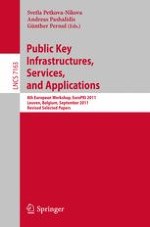2012 | Buch
Public Key Infrastructures, Services and Applications
8th European Workshop, EuroPKI 2011, Leuven, Belgium, September 15-16, 2011, Revised Selected Papers
herausgegeben von: Svetla Petkova-Nikova, Andreas Pashalidis, Günther Pernul
Verlag: Springer Berlin Heidelberg
Buchreihe : Lecture Notes in Computer Science
